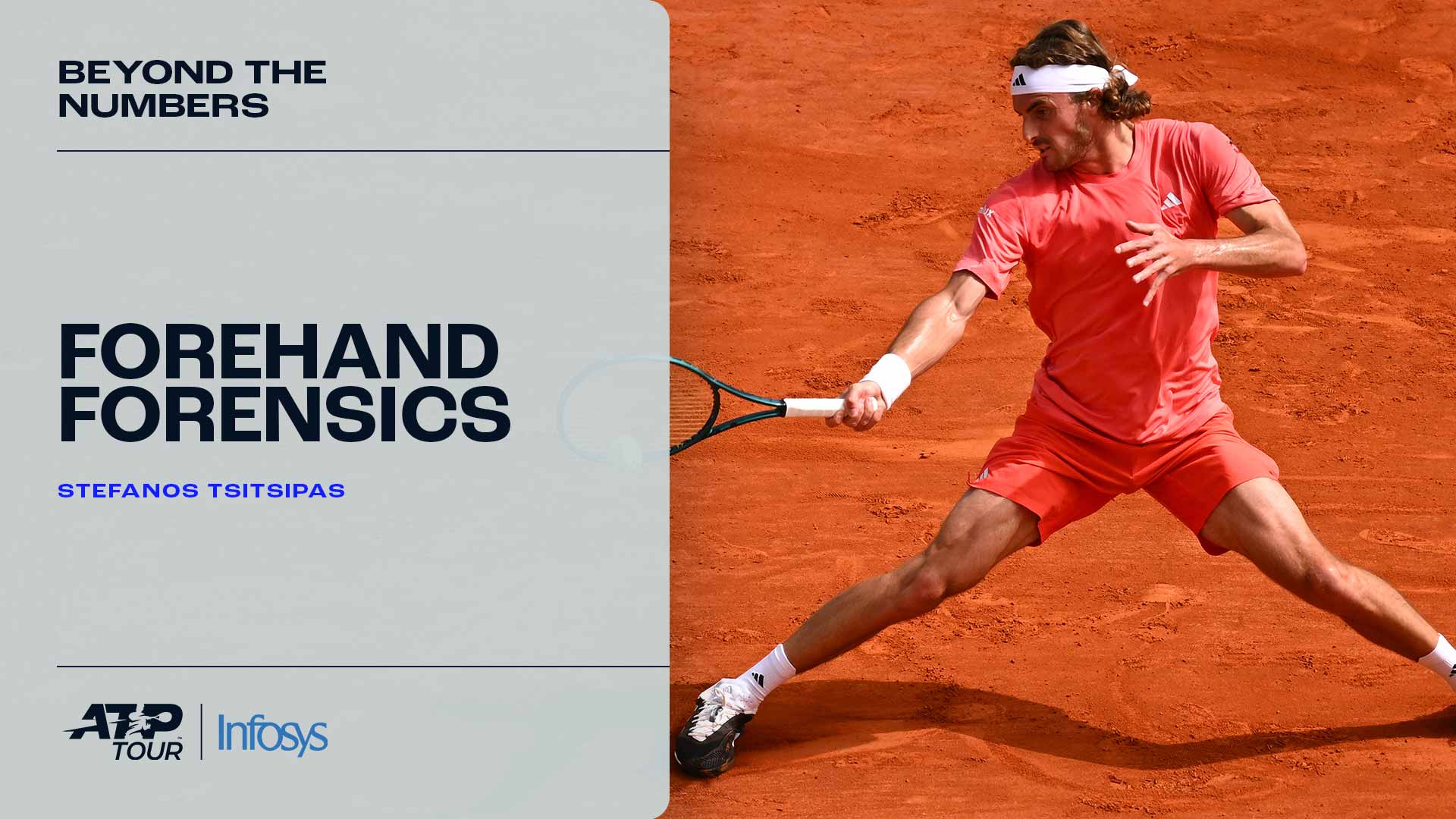

Talk to the forehand.
The conversation surrounding Roland Garros glory for Stefanos Tsitsipas begins and ends with his potent forehand. It thrives on the terre battue and was a key component of his 7-6(7), 6-4, 6-1 first-round victory over Marton Fucsovics in Paris on Monday.
Tsitsipas hit 189 forehands to only 153 for Fucsovics and clubbed 13 winners to eight. The Greek hit more forehand winners and also committed fewer forehand errors (25-26) for the match. An Infosys ATP Beyond The Numbers analysis of Tsitspas’ groundstroke performance in his 11 lead-in matches (9-2) at clay-court ATP Masters 1000 events in Monte-Carlo (champion), Madrid (l. in R2), and Rome (l. in QFs) identifies just how heavily he leans on his forehand to secure victory.
Winners: Tsitsipas vs. Opponents (Monte-Carlo, Madrid & Rome)
| Winners | Tsitsipas | Opponents | +/- |
|---|---|---|---|
| Forehand | 133 | 93 | 40 |
| Backhand | 31 | 46 | -15 |
| Volley | 50 | 37 | 13 |
| Aces | 42 | 46 | -4 |
| Returns | 4 | 11 | -7 |
| TOTAL | 260 | 233 | 27 |
Tsitsipas’ main point of separation from his opponents was from the forehand wing. He struck 133 forehand groundstroke winners to only 93 combined for his 11 opponents. That 40-point differential was the largest of any shot on the court. Tsitsipas is always looking for a run-around forehand standing in the ad-court to blast inside-out for a winner or play back behind his opponent down the line.
What’s interesting is that Tsitsipas’ opponents average hitting the ball slightly harder than the Greek (79 mph to 77 mph), but Tsitsipas generated more spin off both his forehand and backhand wings.
Average Speed & Spin
| Average Speed/Spin | Tsitsipas | Opponents | +/- |
|---|---|---|---|
| Forehand | 77 mph | 79 mph | -2 mph |
| Backhand | 68 mph | 72 mph | -4 mph |
| Forehand Topspin | 3099 rpm | 2853 rpm | 246 rpm |
| Backhand Topspin | 2817 rpm | 1755 rpm | 1061 rpm |
That extra spin is used to get the ball up higher out of the strike zone of his opponents' groundstrokes and also to create more angles in the court to open holes to attack later in the point. Surprisingly, Tsitsipas’ court position was almost identical to his opponents'.
Court Position Relative To The Baseline
| Court Position | Tsitsipas | Opponents | +/- |
|---|---|---|---|
| Inside Baseline | 24% | 23% | 1% |
| 2 Metres Behind | 44% | 45% | -1% |
| Past 2 Metres | 32% | 32% | 0% |
Tsitsipas stood slightly more inside the baseline (24% to 23%) and stood the same deep in the court (32%), more than two metres behind the baseline.
So, if Tsitsipas is not gaining his forehand advantage from hitting the ball harder or has significantly better court position relative to the baseline, how does he go about creating his forehand advantage? By attacking with his forehand as quickly as possible in the point. Tsitsipas was far more dominant in “first-strike” points than everything that followed.
Rally Length: Points Won/Lost
| Rally Length | Tsitsipas | Opponents | +/- |
|---|---|---|---|
| 0-4 Shots (63%) | 505 | 442 | 63 |
| 5-8 Shots (25%) | 197 | 178 | 19 |
| 9+ Shots (12%) | 104 | 84 | 20 |
| TOTAL | 806 | 704 | 102 |
Tsitsipas punches you first with his forehand. His 63-point advantage in the 0-4 shot rally length is full of solid forehands early in the rally that either deliver an immediate knockout blow or provide a commanding advantage to finish soon after.
Tsitsipas next plays German Daniel Altmaier in round two at Roland Garros. Altmaier came through a five-set epic in his opening round, winning 7-5, 6-4, 6-7(6), 5-7, 7-6(10-6) against Laslo Djere. It’s interesting to note that both Tsitsipas and Altmaier have a one-handed backhand from the baseline. Whomever can best match up their forehand to the opponent’s backhand will likely advance to the third round.